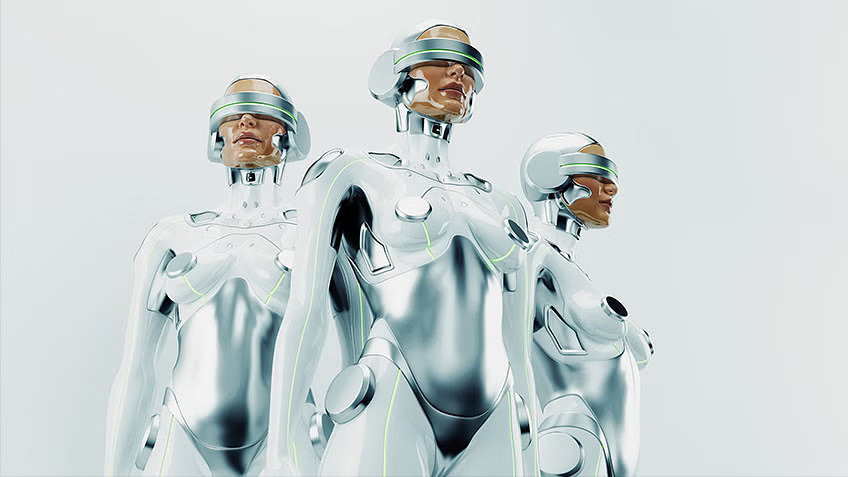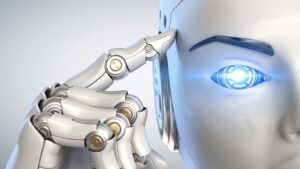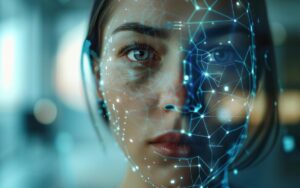Although the terms artificial Intelligence and machine learning are commonly used these days, the difference between the two can still be confusing.
In this article, we’ll explore the key differences between AI and machine learning, their real-world applications, and why understanding these concepts is crucial for anyone looking to advance in tech.
Whether you’re considering an AI ML program or just curious about the technologies shaping our future, this deep dive will give you the clarity you need.
What is Artificial Intelligence?
AI enables computers to perform tasks that typically require human intelligence, such as decision-making, data analysis, and language understanding. Unlike traditional software that follows set instructions, AI systems can learn and improve from their experiences. AI is about making machines more intelligent and capable of helping us with everyday tasks.
AI includes several key areas:
- ML allows computers to learn from data without explicit programming
- Deep Learning, a subset of ML, uses networks like the human brain to tackle more complicated tasks
- Natural Language Processing (NLP) helps computers understand and interpret human language
- Robotics combines AI with engineering to create robots that can learn and work in real-world settings
Also Read: Exploring Tech Innovation: What is Edge AI?
What is Machine Learning?
ML is a key part of AI that helps computers learn and improve from experience without specific instructions. Unlike traditional systems that follow set rules, ML algorithms analyze data to find patterns and make decisions. This allows ML to handle complex tasks such as sorting images, predicting sales, or managing large data sets. The more data these algorithms process, the more accurate they become. You might use ML daily without realizing it. For example:
- Personalized video recommendations on streaming services
- Chatbots that help troubleshoot problems and guide you to resources
- Virtual assistants can schedule meetings, play your favorite songs, or make calls based on your request
The Relationship Between AI and ML
AI and ML are closely related but not the same. AI is all about creating systems that can think and act like humans. This means making machines that can understand language, make decisions, and solve problems.
ML is a tool that helps AI learn and perform tasks using data. Instead of telling a computer exactly what to do, we teach it to learn from examples. Think of it like this: If you want a computer to recognize cats in pictures, you show it many pictures of cats and non-cats. Over time, the computer figures out what makes a cat a cat and gets better at recognizing them.
For instance, it’s ML at work when you get video recommendations on Netflix or YouTube. The system looks at what you’ve watched before and suggests similar content. Similarly, chatbots that help answer your questions are also powered by ML, as they learn from previous interactions to give better responses.
So, AI is about creating smart technology, and ML is the method for helping these systems learn and improve through experience.
Also Read: Tech Innovation Challenges: Exploring Ethics in AI
Machine Learning vs. Artificial Intelligence: Differences
The following are the differences between AI and machine learning.
Objectives
AI is focused on creating systems that can think and act like humans, handling tasks that would otherwise require human intervention. This includes solving complex problems, making decisions, and understanding language. For example, AI systems can help build virtual assistants that respond to questions or automate customer service tasks.
ML is a part of AI that helps computers learn from data. Instead of giving them detailed instructions, ML systems use data to find patterns and improve their performance over time. The main goal of ML is to make predictions or decisions using this data, like suggesting videos you might enjoy on a streaming service or forecasting future sales.
Scope
AI covers a broad range of technologies and methods. It includes techniques like neural networks, rule-based systems, and search algorithms to handle many tasks. AI can be used in many areas, from self-driving cars to understanding human language, making it a flexible and far-reaching field.
ML, on the other hand, is a more focused area within AI. It’s all about teaching algorithms to learn from data and get better at performing specific tasks. For example, ML can help analyze customer behavior or spot fraudulent activity. While ML is a key part of AI, it focuses on specific tasks
Methods
AI uses different methods to solve problems. These methods can include neural networks, genetic algorithms, and expert systems. They can be mixed and matched to create systems that handle complex tasks. For example, AI might use various techniques to build a recommendation engine that suggests movies based on what you’ve watched before.
ML, on the other hand, mainly relies on two methods: supervised and unsupervised learning. Supervised learning involves teaching algorithms using data with known results. Unsupervised learning is used to find patterns in data when the results are unknown beforehand. These techniques are key to how ML systems learn from and make predictions based on the data they receive.
Implementations
Creating AI solutions can be complex since it often involves mixing different technologies and methods. Many businesses opt for ready-made AI tools that can be added to their systems with APIs. This makes it easier to use advanced AI features without building everything from scratch.
ML mainly involves preparing data, choosing suitable algorithms, and training models. This means feeding data into algorithms so they can learn and make better predictions. ML models are updated regularly with new data, which helps them become more accurate and useful over time.
Data Requirements
AI systems can handle different kinds of data, such as organized data (like tables), semi-organized data (like emails), and unorganized data (like free-form text or images). This allows AI to be used in different scenarios, from analyzing text and images to understanding spoken language.
ML, however, usually deals with more structured data types, like spreadsheets or databases. For ML to work well, it needs a lot of high-quality data to train its models. So, managing and preparing this data is essential for ML to perform effectively.
Computational Needs
AI systems often need a ton of computing power, particularly for complex tasks involving large data sets. This often involves using large groups of servers or advanced computing systems to handle the heavy workload.
Similarly, ML requires significant computational resources, though the needs can vary depending on the specific application. Some ML tasks can be handled effectively by a single server or a small group of servers. At the same time, more complex applications may demand additional computing power to achieve the best results.
AI vs. Machine Learning: Similarities
Despite their distinct roles, AI and ML share some core similarities.
Human-Like Problem Solving
AI and ML are tools created to handle difficult tasks and make smart decisions by learning from experience. For instance, AI helps a self-driving car safely navigate the roads using camera data and traffic rules. Similarly, ML can predict a house’s value by looking at previous sales, market trends, and other relevant information.
Fields of Computer Science
AI and ML are fields in computer science that create software to understand and analyze data in detailed ways. The aim is to build systems that can learn and perform tasks as fast as humans. Both fields focus on enhancing efficiency in different industries and drawing valuable insights from data, making computers smarter and more effective.
Cross-Industry Applications
Both AI and ML have wide-ranging applications across different sectors. AI can enhance supply chain management, predict sports results, or personalize skincare routines. Conversely, ML can be used to schedule machinery maintenance, set dynamic travel prices, detect insurance fraud, or forecast retail demand.
Also Read: The Double-Edged Sword of AI Deepfakes: Implications and Innovations
Applications of AI vs. Machine Learning
Here’s a quick look at how AI and ML are making an impact:
Healthcare
In healthcare, AI and ML are used to analyze patient records, predict health outcomes, and speed up drug development. For example, AI can help detect diseases from medical images and monitor patient health in real time.
Manufacturing
Manufacturers use AI and ML to improve efficiency. AI monitors machines to ensure they work smoothly, while ML predicts when maintenance is needed, preventing costly breakdowns. This helps keep production running smoothly.
E-commerce and Retail
AI and ML enhance the shopping experience by managing inventory, forecasting demand, and personalizing offers. For instance, recommendation engines suggest products based on past purchases, making shopping more enjoyable.
Financial Services
In finance, AI and ML improve security and efficiency. They help detect fraudulent transactions, assess financial risks, and automate trading processes, making financial services faster and more reliable.
Telecommunications
Telecom companies use AI to optimize network performance and predict maintenance needs. AI also helps automate business processes, ensuring better connectivity and service.
The Benefits of Combining AI and ML
Here’s how using AI and ML together can benefit organizations:
Access to More Data
AI and ML can handle structured data (like spreadsheets) and unstructured data (like emails or social media posts). Combining these technologies allows businesses to analyze a broader range of data sources, leading to more comprehensive insights and better decision-making.
Quicker Decision-Making
With AI and ML, data processing becomes much faster and more accurate. These technologies reduce human error and enhance data integrity, allowing companies to make informed decisions quickly. This speed can be crucial in fast-paced industries.
Increased Efficiency
AI and ML boost operational efficiency by automating routine tasks and improving data management. This automation cuts down on manual work and helps reduce costs. Efficient systems mean less time spent on repetitive tasks and more focus on strategic goals.
Better Analytics
AI and ML integrate predictive analytics into daily business operations. This integration lets employees get useful insights directly from their reporting tools and apps. As a result, they can make better, data-driven decisions and boost overall business performance.
Also Read: Performance Modeling: What is an ROC Curve?
Become an AI & ML Professional
The differences between AI and machine learning will help you with a basic understanding of these technologies and their uses in our everyday world.
Al and ML are a major part of today’s tech revolution and offer new and emerging job opportunities. If you want to work in this thriving field, taking an AI ML course is a significant step forward.
An industry-recognized AI ML bootcamp like ours is designed to equip you with the necessary skills to start a career as an AI engineer, NLP specialist, research scientist, and more.
FAQs
- What is the difference between machine learning vs. artificial intelligence?
AI is a broad field focused on creating intelligent machines, while ML is a subset of AI that allows systems to learn from data and improve over time. Think of AI as the umbrella and ML as a tool.
- Which is better, AI vs. Machine Learning?
AI and ML serve different purposes. AI aims for overall smartness, while ML is about learning from data. AI is critical if you need general intelligence; ML is your go-to for data-driven improvements. It depends on what you’re aiming for.
- Is ChatGPT AI or ML?
ChatGPT is both! It’s an AI system powered by ML. It uses ML algorithms to understand and generate text, making it a smart AI tool that learns from data to chat and assist effectively.
- Is AI and ML coding?
AI and ML involve coding, but they’re not just coding. AI uses coding to create intelligent systems, while ML uses it to develop algorithms that learn from data. Coding is the tool, but AI and ML are the goals.
You might also like to read:
Artificial Intelligence Career Path
What Is a Generative Adversarial Network? Types, How They Work, Pros, and Cons
What Is Transfer Learning in Machine Learning?
What is Sustainable AI? Definition, Significance, and Examples






